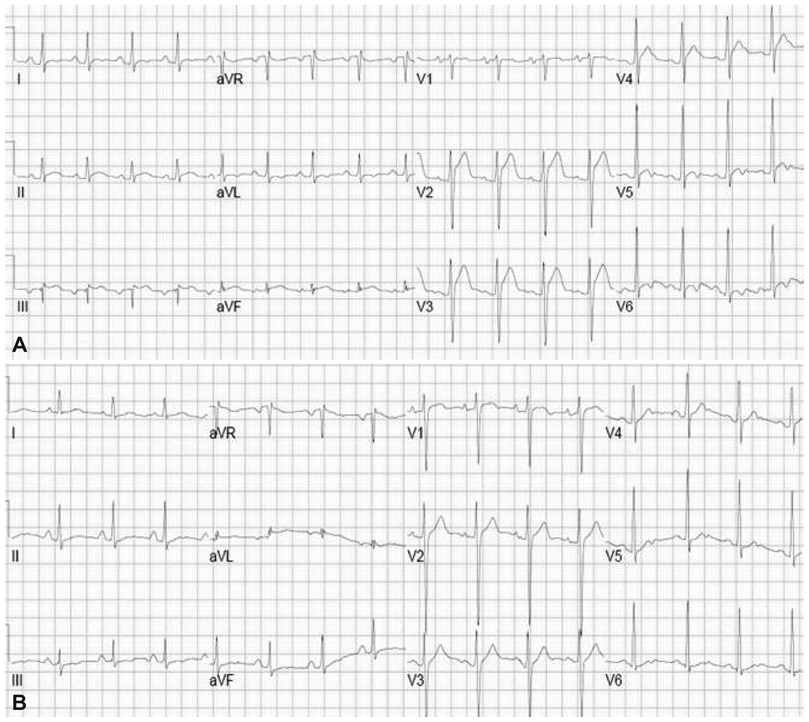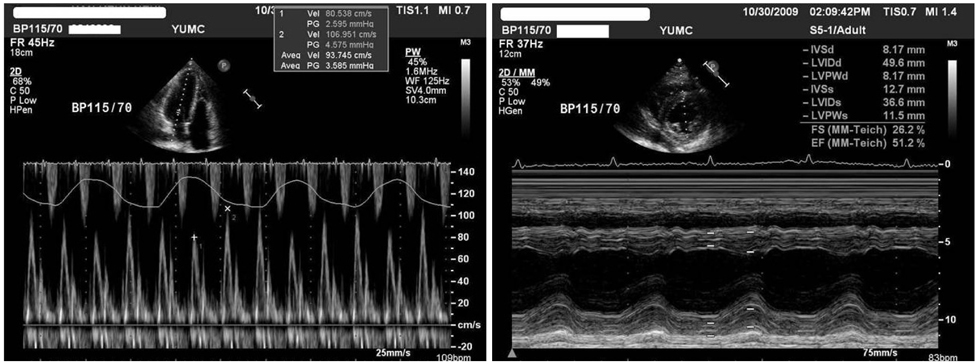Korean Circ J.
2010 Oct;40(10):539-542. 10.4070/kcj.2010.40.10.539.
Constrictive Pericarditis Accompanied by Swine-Origin Influenza A (H1N1) Infection
- Affiliations
-
- 1Department of Cardiology, Cardiovascular Hospital, Severance Hospital, Yonsei University Health System, Seoul, Korea. hjchang@yuhs.ac
- 2Department of Infection, Severance Hospital, Yonsei University Health System, Seoul, Korea.
- KMID: 1826145
- DOI: http://doi.org/10.4070/kcj.2010.40.10.539
Abstract
- Swine-origin influenza A (H1N1) is caused by a new strain of the influenza virus. The disease has spread rapidly and was declared a pandemic in April, 2009. So far, however, there is a scarcity of information regarding the complications of swine influenza. A report of the disease in the winter of 2009 in the Southern Hemisphere found that the most common manifestations of influenza A virus infection are upper respiratory tract infection and pneumonia. Although there may be an association between fulminant myocarditis and Swine influenza, cardiovascular complications resulting from swine Influenza A infection are exceedingly rare. We report a case of acute constrictive pericarditis in a healthy subject infected by the swine-origin influenza A (H1N1) virus.
MeSH Terms
Figure
Reference
-
1. Webb SA, Pettila V, Seppelt I, et al. Critical care services and 2009 H1N1 influenza in Australia and New Zealand. N Engl J Med. 2009. 361:1925–1934.2. Bratincsák A, El-Said HG, Bradley JS, Shayan K, Grossfeld PD, Cannavino CR. Fulminant myocarditis associated with pandemic H1N1 influenza A virus in children. J Am Coll Cardiol. 2010. 55:928–929.3. Coker R, Mounier-Jack S. Pandemic influenza preparedness in the Asia-Pacific region. Lancet. 2006. 368:886–889.4. Pandemic (H1N1) 2009-update 75. Accessed Nov 20, 2009. geneva: World health Organization;Available from: http://www.who.int/csr/don/2009_11_20a/en/index.html.5. Pandemic (H1N1) 2009-update November, 21, 2009. Korea Center for Disease Control and Prevention. Accessed Nov 21, 2009. Available from: http://flu.cdc.go.kr/sub/h1n1OntogenyStatus.jsp.6. Jain S, Kamimoto L, Bramley AM, et al. Hospitalized patients with 2009 H1N1 influenza in the United States, April-June 2009. N Engl J Med. 2009. 361:1935–1944.7. Centers for Disease Control and Prevention (CDC). Neurologic complications associated with novel influenza A (H1N1) virus infection in children - Dallas, Texas, May 2009. MMWR Morb Mortal Wkly Rep. 2009. 58:773–778.8. Kitaura Y, Deguchi H, Terasaki F, Ukimura A, Morita H, Tatsumi T. Influenza myocarditis: pathophysiology and developmental mechanism of myocarditis. Nippon Rinsho. 2003. 61:1945–1952.9. Mamas MA, Nair S, Fraser D. Cardiac tamponade and heart failure as a presentation of influenza. Exp Clin Cardiol. 2007. 12:214–216.10. Nolte KB, Alakija P, Oty G, et al. Influenza A virus infection complicated by fatal myocarditis. Am J Forensic Med Pathol. 2000. 21:375–379.11. Sagrista-Sauleda J, Permanyer-Miralda G, Candell-Riera J, Angel J, Soler-Soler J. Transient cardiac constriction: an unrecognized pattern of evolution in effusive acute idiopathic pericarditis. Am J Cardiol. 1987. 59:961–966.12. Ha CB, Huh JY, Shin YW, Shin YK. Doppler flow patterns of constrictive pericarditis. Korean Circ J. 1989. 19:47–54.13. Oh JK, Hatle LK, Mulvagh SL, Tajik AJ. Transient constrictive pericarditis: diagnosis by two-dimensional Doppler echocardiography. Mayo Clin Proc. 1993. 68:1158–1164.14. Napolitano G, Pressacco J, Paquet E. Imaging features of constrictive pericarditis: beyond pericardial thickening. Can Assoc Radiol J. 2009. 60:40–46.15. Kim CW. Constrictive pericarditis and pericardiectomy. Korean Circ J. 1979. 9:71–81.16. Haley JH, Tajik AJ, Danielson GK, Schaff HV, Mulvagh SL, Oh JK. Transient constrictive pericarditis: causes and natural history. J Am Coll Cardiol. 2004. 43:271–275.
- Full Text Links
- Actions
-
Cited
- CITED
-
- Close
- Share
- Similar articles
-
- Acute Pericarditis with Pericardial Effusion That Developed after Swine Influenza A (H1N1) Infection in a Healthy Adult
- Novel swine-origin H1N1 influenza
- Novel Swine-Origin Influenza A (H1N1) Viral Encephalitis
- Experience for S-OIV of Admission Pediatric Patient with S-OIV at YUMC, 2009
- Epidemiology, clinical manifestations, and management of pandemic novel Influenza A (H1N1)




